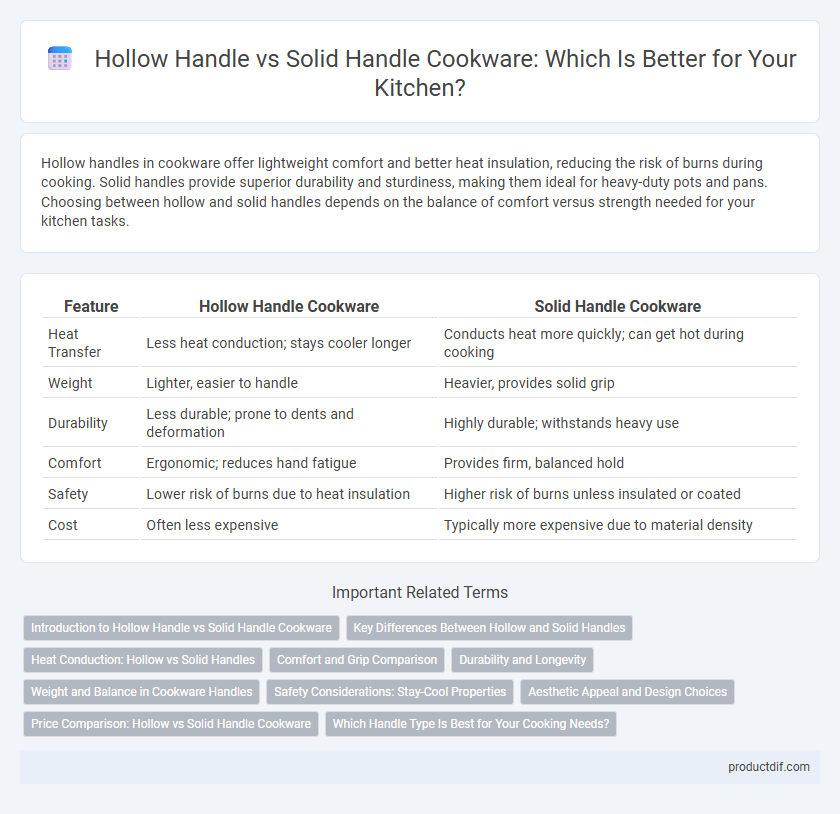Hollow handles in cookware offer lightweight comfort and better heat insulation, reducing the risk of burns during cooking. Solid handles provide superior durability and sturdiness, making them ideal for heavy-duty pots and pans. Choosing between hollow and solid handles depends on the balance of comfort versus strength needed for your kitchen tasks.
Table of Comparison
| Feature | Hollow Handle Cookware | Solid Handle Cookware |
|---|---|---|
| Heat Transfer | Less heat conduction; stays cooler longer | Conducts heat more quickly; can get hot during cooking |
| Weight | Lighter, easier to handle | Heavier, provides solid grip |
| Durability | Less durable; prone to dents and deformation | Highly durable; withstands heavy use |
| Comfort | Ergonomic; reduces hand fatigue | Provides firm, balanced hold |
| Safety | Lower risk of burns due to heat insulation | Higher risk of burns unless insulated or coated |
| Cost | Often less expensive | Typically more expensive due to material density |
Introduction to Hollow Handle vs Solid Handle Cookware
Hollow handle cookware features a lightweight design that enhances maneuverability and prevents heat retention, reducing the risk of burns during cooking. Solid handle cookware offers superior durability and a sturdy grip, providing balanced control and heat conduction that can aid in cooking precision. Choosing between hollow and solid handles depends on preferences for weight, heat resistance, and handling comfort in kitchen tasks.
Key Differences Between Hollow and Solid Handles
Hollow handles in cookware offer lighter weight and improved heat insulation, reducing the risk of burns during cooking. Solid handles provide greater durability and a more robust grip, often preferred for heavy pots and pans. The choice between hollow and solid handles impacts heat conduction, weight balance, and overall user comfort in the kitchen.
Heat Conduction: Hollow vs Solid Handles
Hollow handles on cookware are designed to reduce heat conduction, keeping the handle cooler and safer to touch during cooking. Solid handles, typically made from metal, conduct heat more quickly and may require additional insulation or pot holders for safe handling. Choosing hollow handles enhances user comfort by minimizing heat transfer, especially during prolonged cooking sessions.
Comfort and Grip Comparison
Hollow handles in cookware offer lightweight comfort, reducing arm fatigue during extended cooking sessions, while solid handles provide a sturdier grip that enhances control and stability. The design of hollow handles often includes heat-resistant materials to prevent burns, but solid handles excel in delivering a more secure and balanced hold, especially when maneuvering heavy pots or pans. Ergonomically, solid handles typically feature textured or contoured surfaces that improve friction, making them superior for maintaining a firm grasp under wet or greasy conditions.
Durability and Longevity
Solid handles in cookware typically offer superior durability and longevity due to their robust construction and resistance to bending or breaking under heavy use. Hollow handles, while often lighter and cooler to the touch, may be more prone to dents and damage over time, especially with frequent exposure to high heat. Choosing cookware with solid handles ensures enhanced strength and extended lifespan, making it ideal for rigorous cooking environments.
Weight and Balance in Cookware Handles
Hollow handles in cookware significantly reduce overall weight, enhancing comfort during extended use and minimizing wrist strain. Solid handles provide superior balance and stability by offering a denser grip, allowing precise control when maneuvering heavy pots or pans. Choosing between hollow and solid handles depends on whether lightweight handling or enhanced control is the priority for your cooking needs.
Safety Considerations: Stay-Cool Properties
Hollow handles in cookware are designed to dissipate heat more effectively, reducing the risk of burns by staying cooler during stovetop cooking. Solid handles, typically made from metal, tend to absorb and retain heat, requiring additional insulation or gloves for safe handling. Choosing hollow handles enhances safety by minimizing heat transfer and ensuring a comfortable grip without compromising cooking performance.
Aesthetic Appeal and Design Choices
Hollow handles in cookware offer a sleek, lightweight design that enhances aesthetic appeal through a modern and streamlined look, often incorporating polished metal finishes or color accents. Solid handles, by contrast, provide a robust and traditional appearance, delivering a sense of durability and classic craftsmanship favored in high-end chef's pans and artisanal cookware. Design choices between hollow and solid handles impact not only the visual style but also ergonomics, with hollow handles lending themselves to minimalist, contemporary kitchens and solid handles appealing to rustic or professional culinary settings.
Price Comparison: Hollow vs Solid Handle Cookware
Hollow handle cookware generally costs less due to reduced material usage and lighter construction, making it an economical choice for budget-conscious buyers. Solid handle cookware, often crafted from durable metals like stainless steel, commands higher prices reflecting enhanced heat resistance and longevity. Consumers should weigh cost differences against performance needs when selecting between hollow and solid handle cookware.
Which Handle Type Is Best for Your Cooking Needs?
Hollow handles in cookware provide lightweight comfort and improved heat dispersion, making them ideal for long cooking sessions and easy maneuverability. Solid handles offer superior durability and heat resistance, suited for high-heat cooking and frequent stovetop use without risk of warping or damage. Choosing between hollow and solid handles depends on your cooking style, with hollow handles favored for lighter tasks and solid handles preferred for robust, heavy-duty cooking needs.
Hollow Handle vs Solid Handle Infographic

 productdif.com
productdif.com